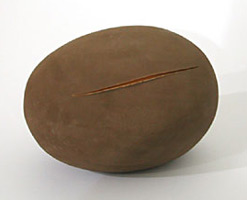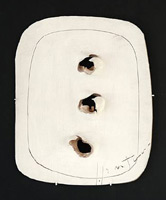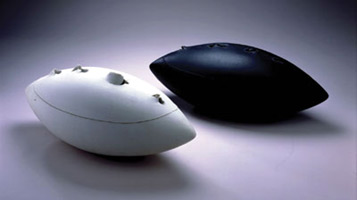Terebess
Kerámia Lexikon
«
vissza a Terebess Online nyitólapjára
«
vissza a Terebess Ázsia Lexikonra
«
vissza a Terebess Cseréptárlatra
A B C D E F G H I J K L M N O P R S T U V W Y Z
Lucio Fontana kerámiái
“Fontana nemcsak keramikus is volt, hanem egyike a legfontosabb művészeknek, akik ebben a műfajban dolgoztak a 20. században.” Garth Clark

Lucio Fontana (1899, Rosario di Santa Fé, Argentína - 1968, Varese,
Olaszország)
Argentin születésű olasz művész. Milánóban folytatott tanulmányok és különböző
anyagkísérletek után a harmincas években fordult az absztrakt és expresszív
kifejezési formák felé. 1934-ben készítette első absztrakt szobrait, 1935-ben
tagja lett az Abstraction-Création csoportnak, elkezdett kerámiákat készíteni
Albisolában, majd Sevres-i gyárban, több díjat is kapott értük. 1938. szeptember
7-én a Gazzetta del Popoloban, Marinettivel és másokkal kiadta a "Ceramica
e Aereoceramica" futurista manifesztumot. 1939 és 1946 között
Argentínában élt, ahol kiadta a "Manifesto Blanco"-t (Fehér manifesztum),
majd Milánóba visszatérve más művészek és kritikusok által is aláírt "Primo
Manifesto dello Spazialismo"-ban fogalmazta meg és dolgozta ki a Spazialismo
(spacializmus) elméletét, amely a reális tér, az energia és a dinamizmus szerepét
hangsúlyozta a művészetben. 1949-től készítette "Concetti spaziali"-nak
nevezett, átlyuggatott ("Buchi") és felhasított ("Tagli")
monokróm vásznait, bevonva a környező teret és a fényt festészetébe, majd
később, hasonló elvek alapján, szobrászatába és kerámiáiba is.
Erdősi
Anikó: Felsebzett vörösrezek – Fontana fémei
Alexandra Kreer: A "színes szobor" problematikája Lucio Fontana művészetében,
Balkon, 1999/1-2, 4-7. o.
Kreer Tóth Alexandra: Lucio Fontana, a keramikus. Az iparművészet mezsgyéjén,
Magyar iparművészet, 1999/4. 17-19. o.

Crocifisso (Crucifix)
1955-1957

Angioletto
1950-1955
Glazed ceramic
12 x 12.5 x 21 cm

Lot
403 - BATTAGLIA EQUESTRE
colored ceramic
signed and dated '47
h: 12 x w: 14 x d: 8 cm

Concetto
spaziale, 1965
painted terracotta, unique
12 x 12 x 12 inches
30.5 x 30.5 x 30.5 cm
SW 00340
Private Collection

Concetto
spaziale
1960-65
Terracotta
15.5 cm x 23 cm.

"Sfere"
Maiolica e terracotta verniciata
Milano, 1957

Concetto
spaziale
1957
Terracotta
h: 45 cm

Untitled
1958
painted terracotta
h: 46 x w: 46 cm

Concetto
spaziale
1947
painted terracotta
h: 44 x w: 44 cm

Concetto
Spaziale
1957
Painted terracotta
Recto signed and dated: l fontana 57
Verso inscribed, signed and dated
Diameter 43 cm

Piatto
concetto spaziale
1961
Glazed ceramic
h: 37 cm

Concetto
Spaziale
1960-1962
Painted ceramic
Signed on the right
h: 38 x w: 30 cm


Concetto
Spaziale - cratere
1968
Black unglazed porcelain
Multiple - ceramics
Signed and numbered a tergo L. Fontana edition of 75 Ars porcellana Rosenthal
relief reihe
h: 38 x w: 29 cm
Even though it was to be seen as an edition each work is an unique work in its self, due to the fact that each was individually incised and either slashed or punctured by Fontana himself. Another fact is, as per Rosenthal, that not even half of the initially planned 75 were made.
The Concetto Spaziale Cratere White and Concetto Spaziale Cratere Black are among Fontana’s final work in ceramics and were produced as a series in porcelain by Rosenthal. What is unusual about this series is that they combine mechanical and manual production. Rosenthal made the bodies from a mold, and Fontana then added the punctured holes and oval gashes by hand, making each object in the series different.
Chief Curator and Curator of Decorative Arts at the Carnegie Museum of Art, CMOA, Sarah Nichols says, “The pieces were conceived to stand alone or to be paired and, I think, by pairing, the sum is greater than the individual parts. It speaks to another important aspect of Fontana’s work—opposites creating a whole or the two sides of the coin of life.” Nichols adds, “The pair might stand for light and dark, day and night, male and female, or the hand and the machine.”

Concetto
Spaziale and Concetto Spaziale Black
1968
ceramics

Concetto
Spaziale
circa 1960-1963
Ceramic
44 x 44 cm

Concetto
Spaziale
1963
Ceramics
További
képek:
http://www.astebabuino.it/Risultatiaste/risultati.feb08.asp?page=1
http://www.astebabuino.it/Risultatiaste/risultati.feb08.asp?page=2
Biography
of Lucio Fontana
By the
Lucio Fontana Foundation
Ideas
are not scorned, they germinate in society and are then expressed by philosophers
and artists
(from the Manifesto Blanco, Buenos Aires, 1946)
Lucio
Fontana was born in Rosario in the Santa Fé region of Argentina on 19th February
1899. His Italian father, Luigi, who had lived in Argentina for ten years,
was a sculptor, and his mother, Lucia Bottino, also of Italian origin, was
a theatre actress. When he was six years old, he went with his father to Milan
to attend school. By 1910 he had already begun his artist's apprenticeship
in his father's workshop. He later enrolled in a school for Master Builders,
before leaving to enlist as a volunteer in the First World War. Wounded, and
discharged with a silver medal for military bravery, he took up his studies
again and obtained his diploma. In 1921, he returned to Argentina, and began
working as a sculptor in his father's workshop in Rosario. He later opened
his own studio in the same city. Between 1925 and 1927, he won several competitions,
and produced, amongst other things, the monument to Juana Blanco.
He returned to Milan in 1928 to enrol in the 1st course at the Brera Academy
as a student of Adolf Wildt. At the end of the year, he was moved up to the
fourth level. In the meantime, he took part in exhibitions and competitions
in Italy, Spain and Argentina. In 1930 he met Teresita Rasini, whom he was
later to marry. Moving freely between figurative and abstract, his sculpture
in terracotta and clay, with and without colour, gradually acquired greater
freedom and individuality. During these crucial years for his artistic development,
he gained increasing recognition from leading critics including Argan, Belli,
Persico and Morosini and took part in the Milan Triennial, the Venice Biennial
and the Rome Quadrennial. He also held several exhibitions at the Milione
Gallery and began working in ceramics, first at Albisola and then in 1937
at the Sevres Factory, where he completed several small sculptures which he
exhibited and sold in Paris. By this time he was working closely with avant-garde
architects. In early 1940 he settled in Buenos Aires and worked feverishly,
winning numerous sculpture competitions. Professor of sculpture at the School
of Fine Arts, in 1946 he got together with others to set up a private art
school called the Academy of Altamira, which was to become an important centre
for the promotion of culture. It was here that, in constant contact with young
artists and intellectuals, he formulated his theories on artistic research,
which would lead to the publication of the Manifesto Blanco.
On returning to Milan in April 1947, Fontana founded the Movimento spaziale
(Spatial Movement) and, together with other artists and intellectuals, published
the Primo Manifesto dello Spazialismo (First Manifesto of Spatialism). He
went back to working as a ceramist in Albisola and resumed his collaboration
with architects. The following year saw the publication of the Secondo Manifesto
dello Spazialismo (Second Manifesto of Spatialism). In 1949 he exhibited L'ambiente
spaziale a luce nera (The spatial environment in black light) at the Naviglio
Gallery, which sparked both enthusiasm and outcry. In the same year, he came
up with his most original invention when, perhaps inspired by his origins
as a sculptor and in search of a third dimension, he produced his first paintings
in which he perforated the canvasses. In 1950 he published the Terzo manifesto
spaziale. Proposta per un regolamento (Third Spatial Manifesto. A Proposal
for Regulation). In 1951, at the Ninth Triennial, where he was the first person
to use neon as an art form, he wrote his Manifesto tecnico dello Spazialismo
(Technical Manifesto of Spatialism). In 1952 he took part in a competition
for the Fifth Door of the Cathedral of Milan and was joint winner with Minguzzi.
In the same year, he and other artists signed the Manifesto del Movimento
Spaziale per la Televisione (Manifesto of the Spatial Movement for Television),
and he exhibited his completed spatial works at the Naviglio Gallery in Milan.
Again prompting both enthusiasm and shock, Fontana was no longer limiting
himself to making holes in canvasses, but was also painting them and applying
colours, inks, pastels, collages, sequins and fragments of glass. By now he
had gained international acclaim. In 1957, a series of works on linen paper
featured not only the holes and graffiti but also the first hints of the cuts
which would be fully expressed the following year. These included canvasses
with a number of coloured cuts to monochrome canvasses entitled Concetto spaziale
(Spatial Concept) and Attesa (Wait). He took part in numerous exhibitions
and international displays and his work was purchased by museums, galleries
and the most respected collectors. A man of enormous generosity, Fontana was
always ready to help young artists even when he lacked the material means.
He encouraged them, bought their works and gave them his own, even though
he knew they would usually be sold straight away. During those years, as well
as making iron sculptures on stems, Fontana made a series of works in terracotta,
known as Nature, spherical shapes with wide lacerations and gashes. He also
continued to produce large and small format ceramics and collaborated with
eminent architects on "environnement" works entitled Ambiente spaziale
(Spatial Environment) in which he used light as an innovative element with
a technique later to be adopted by other artists. In the sixties, Fontana
devoted his attention to a series of oval oil paintings, all in the same format,
monochrome and perforated with numerous holes and slashes, and sometimes sprinkled
with sequins, called Fine di Dio (The End of God). He returned to the same
subject in 1967 with a series of ellipses on lacquered wood with brilliant
colours, unique works created to his design. Between 1964 and 1966 he invented
Teatrini: frames made of modelled and lacquered wood containing monochrome
perforated canvasses. He did not, however, abandon the "cuts", which
he continued to use until the end of his life. In 1966, the international
jury of the 33rd Venice Biennial awarded him first prize for painting for
his white room, featuring white canvasses each with a single vertical slash.
After leaving Milan and moving back to the old farmhouse he had had restored
in Comabbio, his family's town of origin, he died on 7th September 1968. The
presence of Fontana's works in the permanent collections of more than a hundred
museums worldwide further testifies to the importance of his art.